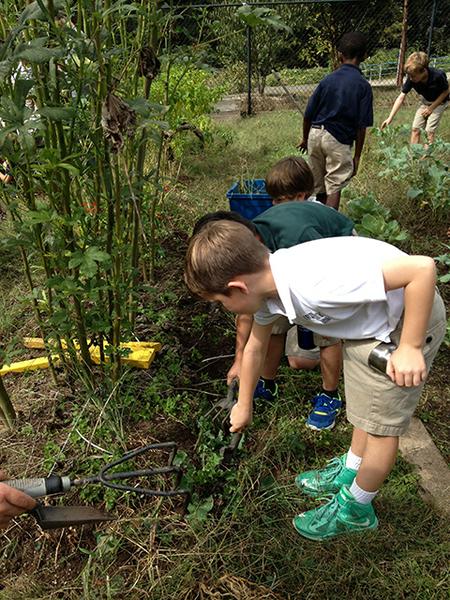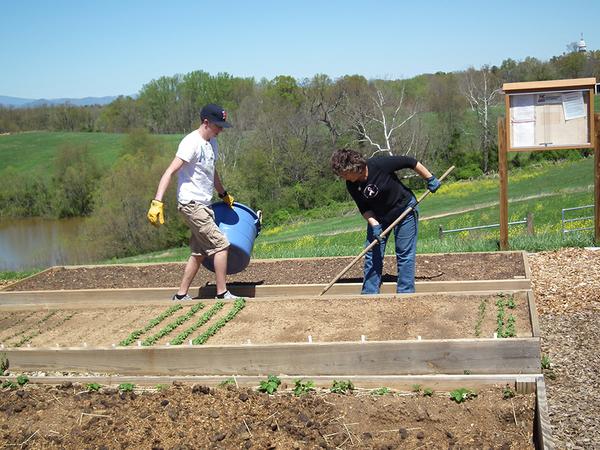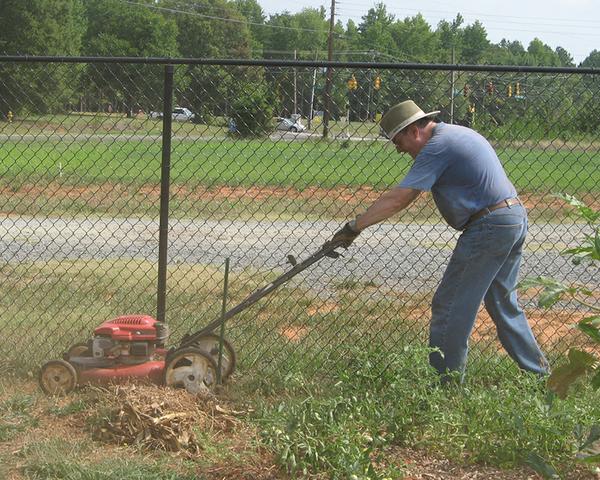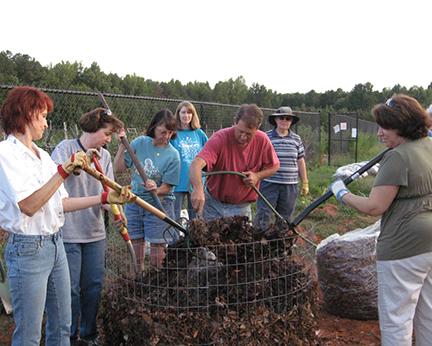Managing a community food garden, day in and day out, is every bit as important as starting the garden. Although we discuss organization and on-going management and maintenance in separate chapters, these activities overlap in the garden. Mobilize the gardeners to help manage the garden. On-going, hands-on maintenance tasks are ideal for sharing responsibility, strengthening community, and cultivating grass-roots leadership.
Soil Stewardship
Soil stewardship is so critical to the success of any food garden that this manual addresses it separately in chapter 8, Soil, Plots, and Planters.
Caring for Paths
An active, well-organized committee is essential to regularly maintain paths and common areas. This maintenance is critical to prevent grass and weeds from spreading. Assign gardeners responsibility for taking care of the small access paths adjacent to where they garden. If necessary, request assistance from a sponsor or public agency to hire someone to help with maintenance activities, or look for a way to swap vegetables for work with an interested neighbor or someone on the wait-list for a garden plot.
Mulched Paths
New mulch must be applied to paths annually because mulch breaks down rapidly during North Carolina’s warm, wet summers. Mulch must be 4 or more inches deep to effectively suppress weeds.
A few weeds always manage to establish themselves even in the best-managed mulched paths. Remove weeds regularly by cultivation, use of a flamer, or precise spot application of herbicide.
Mowed Paths
Grow turf grass, clover, or mowed volunteer vegetation on paths and gathering places as an alternate to mulch. These living paths and areas require regular weekly mowing throughout the growing season. Discourage gardeners from allowing their plants to grow onto paths, because unruly garden vegetables, such as squash, can make mowing more tedious, time-consuming, and potentially contentious.
Paved or Gravel Paths
Some gardens install gravel paths, pavers, or paved paths for main pathways. These can be attractive and accessible; however, not even these are maintenance free. Gravel paths particularly can be quickly overrun by weeds. All require active and regular intervention.
Control annual weeds by eliminating them when they are young and not allowing them to go to seed. To prevent weed seeds from spreading throughout the garden, never let plots, fence lines, or other garden areas become overgrown and neglected.
Controlling perennial weeds (ones that come back every year) should start before the garden is in place. Deal with perennials such as milkweed, nutsedge, and wild blackberries by digging out the roots and bulbs. Be persistent about cutting back the top growth to eliminate photosynthesis. Workdays can target these troublemakers.
Weeds tend to thrive along fence lines, around the garden sign and kiosk, in the composting area, and in shared group plots and flower beds. Be sure someone is clearly assigned the responsibility for regular weed control in each of these areas. Use a sturdy commercial string trimmer to intervene before things get out of hand.
For ideas on controlling bermudagrass, a particularly persistent problem, see chapter 13, Troubleshooting.
Information Kiosk or Bulletin Board
Maintaining the information kiosk or bulletin board is an ideal task for a communications committee. The committee keeps the board looking good and regularly checks to make sure no objectionable materials have been posted.
Plot and Planter Markers
Check plots and planters regularly to make sure that each plot’s address sign is in good shape, attractive, and easy to read. Repair or replace signs as needed. Check to make sure plot corner posts are secure. For planters, check to make sure the sides are stable and corners are securely nailed or screwed in place.
Hoses and Water Taps
Because of heavy use, water taps frequently develop minor problems. Learn how the taps work, how to fix common problems, and how to close the master valve in case of a major leak. Hoses also get plenty of use and sometimes need mending. In the shed, if the garden is lucky enough to have one, keep a box of hose mending supplies and replacement parts for items that often break on water taps. In the winter, drain hoses and store them in the shed.
Signs, Sheds, Seats, and Shelters
Signs, sheds, seats, shelters, bulletin boards, gates, and other garden components need to be checked regularly and repaired as needed. Keep a careful eye out for screws and nails that have worked loose.
Wasps
Paper wasps sometimes make their homes under a roof overhang or at the top of a kiosk, and yellow jackets may make underground nests. Eliminate nests in heavily trafficked places as soon as possible. Seek expert help if gardeners are not experienced doing this kind of work.
Consider leaving nests undisturbed (and well-marked) if they are out of the way. Wasps help control caterpillars and other pests, and existing nests may help prevent establishment of new wasp colonies.
Snakes
Although many gardeners may be fearful of snakes, the vast majority of snakes are harmless and benefit the garden by controlling true pests, such as rodents. To minimize problems, keep the garden, especially storage areas, free from weeds, brush, and piles of old bricks and lumber.
Gathering Places
High traffic areas, such as the gathering or picnic area and the toilet facility, need regular inspection and cleanup. If the garden has a children’s area, make sure it stays attractive and safe. Check frequently for toys and tools left behind.
Community gardeners mostly use hand tools such as rakes, shovels, hoes, and wheelbarrows. Keeping up with garden site maintenance is much easier if the garden has regular access to basic landscaping power tools, especially a good mower and a string trimmer. A garden shed for storing equipment, tools, and garden supplies is very helpful. Placing a solar panel on the roof of the shed is a great way to ensure that battery powered tools are always charged and ready to go.
Recycling and Trash
Every garden produces recycling and trash. The garden should have appropriate containers for each, clearly marked, and emptied weekly. Most organic materials, such as weed stalks, crop wastes, and old mulch, should be composted and never put in a trash container.
Composting and Bulk Storage
The composting area deserves a special note for maintenance, because of its potential to grow a massive crop of weeds, particularly in late summer.
The same caution pertains to the bulk storage area, which is frequently near the compost area. Stockpiles of wire cages, wood, stakes, and other garden materials may be frugal, but they make weeding difficult. Think carefully about maintenance when setting up these areas. Review the discussion in chapter 4, Food Garden Design, for more details.
Community Food Garden Maintenance Calendar for North Carolina
Community food garden maintenance follows the annual cycle below in the North Carolina piedmont. Adjust accordingly for the mountains and the coastal plain.
| Spring |
All Gardener Meeting
Hold an all gardener meeting early in the year (typically in February or March) to welcome gardeners and find out how many will be returning for the coming gardening year. This is a convenient time to pay dues (if any) and sign agreements and to make sure all gardeners have an up-to-date set of guidelines. If the group elects officers and a head gardener, this is a good time to hold the vote; if these positions are appointed or self-appointed, it is important to introduce the people serving in these roles to the group and provide their contact information.
At the meeting, discuss how the garden will handle maintenance for the coming year. Select a maintenance committee chairperson who works well with people and understands maintenance needs; sign up gardeners for the committee and special tasks; and set up a calendar for workdays, regular chores, and community building events such as classes, gatherings, parties, and celebrations. A “pep talk” and a report on the previous year are often parts of this important meeting, along with a visit by the County Extension Director and representatives of the sponsor, key support organizations, and the local community.
Early Spring Workday
A major workday in late February or early March helps prepare the garden for the coming growing season. Replenish paths with mulch, assess winter weed growth, and generally clean up after winter. This workday is a good opportunity for a large volunteer group that wants to help in the garden. Gardeners can begin preparing beds at this time. As early as February and March, gardeners in the piedmont begin planting cool-season crops such as peas, potatoes, and onions.
Spring Cool-Season Planting Day
Mid-March is a good time for a spring planting day for cool-season vegetables, such as lettuce, broccoli, and root crops. Experienced gardeners are often very interested in getting soil prepared and crops planted at this time of year, so leave some time for individual work as part of the workdays. Important all-garden tasks to accomplish at this time include controlling winter weeds, cleaning up beds, and performing maintenance on winter compost piles.
Mowing and Weeding (throughout the growing season)
From mid-March through November, weeding, mowing, and general care continue on a weekly basis. Even if the garden has mulched paths, there will be areas that need regular mowing and weed trimming. As areas are harvested in plots or in the cooperative garden, encourage planting summer cover crops to protect and improve soil and suppress weeds.
Warm-Season Planting Day
April 15 marks the piedmont planting date for warm-season crops such as tomatoes, squash, green beans, and sweet corn. The warm-season planting day can be an enjoyable day in the garden for planting, sowing, and thinking about something other than taxes.
| Summer |
Continue weekly maintenance (grassed paths may need more frequent mowing during the summer).
Mid-Summer Workday and Open House
Gardens can look very attractive from mid-May through mid-July, making this a good time for an open house. The weekend before, hold a workday to get everything in the garden looking its best.
Back to School Cleanup/Fall Cool-Season Planting Day
Plan a late summer/back to school cleanup day to control the rampant growth of summer weeds. This workday is a key time for continuing maintenance and for dealing with pests, such as fire ants and yellow jackets. August is also the time to begin planting fall crops in the piedmont and coastal plain, so gardeners will want time for personal work during workdays.
| Fall |
Continue weekly maintenance in the fall.
Mid-Fall Activities
Mid-September is the rough cut-off date for fall plantings in the piedmont, even for quick crops such as radishes and mustard greens, unless gardeners plan to use row covers. Before the end of September, plant a cover crop in beds that will not be used to grow vegetables over the winter. Crimson clover, winter ryegrass, and other cover crops prevent weeds and erosion while improving soil. For more information see Chapter 8, Soil, Plots and Planters.
Late Fall Harvest Festival, Garlic Day and Tasks before Frost
When summer crops are joined by fall greens, the garden is beautiful and presents the opportunity for a harvest festival. In October, encourage gardeners to clean their plot of weeds and the remains of summer crops. A festival can be a good incentive to get this important round of garden cleanup done in a timely way. On or about October 15 is the traditional planting day for garlic in the piedmont, which provides another good excuse to hold a garden gathering combining work and fun.
Be sure to harvest sweet potatoes and rambling squash vines along fences before frost.
Compost and Mulch Party
After leaves begin falling in November and December, hold a compost and mulch party to make a compost windrow and storage area for bags of leaves, which make ideal mulch. Gardeners save money and set a good environmental example by making their own compost and mulch from fallen leaves.
Late Fall Cleanup
Hold a garden-wide cleanup in late fall after Thanksgiving and the first killing frosts. Completely clean the garden of weeds, finished vegetables and flowers, and materials such as trellises and stakes. In plot gardens, each plot holder is responsible for cleaning their own plot. Allow gardeners to neatly stockpile garden supplies under a tarp in a corner of their plot for the coming year. Late fall is also an optimal time to apply lime (if the need is indicated by a soil test) and perform needed tilling.
| Winter |
Community food gardens in the piedmont are generally not highly active from mid-December through February. Maintenance on paths and winter weeds may be necessary, however. With the growing popularity of season extending techniques, the garden may want to experiment with row covers or even consider building a hoop house to allow production in all seasons.
Publication date: Aug. 10, 2017
AG-806
Other Publications in Collard Greens and Common Ground: A North Carolina Community Food Gardening Handbook
N.C. Cooperative Extension prohibits discrimination and harassment regardless of age, color, disability, family and marital status, gender identity, national origin, political beliefs, race, religion, sex (including pregnancy), sexual orientation and veteran status.






